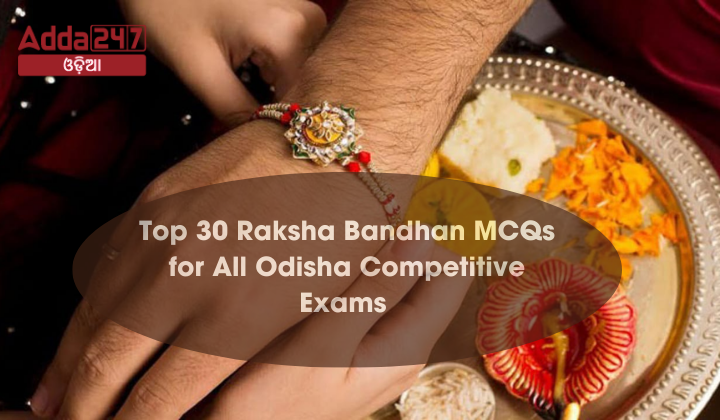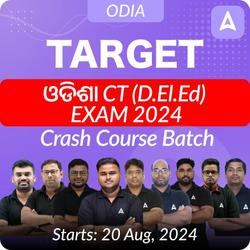Raksha Bandhan, a significant festival in India, symbolizes the bond between brothers and sisters. It is celebrated with great enthusiasm across the country, particularly in Odisha, where cultural traditions are deeply rooted. This festival is not just about tying rakhis and exchanging gifts; it also reflects the values of love, protection, and commitment. Understanding the cultural and historical significance of Raksha Bandhan is essential for various competitive exams in Odisha. Here are the top 30 multiple-choice questions (MCQs) on Raksha Bandhan to help you prepare for your exams.
Top 30 Raksha Bandhan MCQs for All Odisha Competitive Exams
1. The festival of ‘Raksha Bandhan’ started from the day when:
A. Lakshmi Devi tied rakhi to King Bali
B. Draupadi offered a torn piece of her sāṛī to tie Shrīkrushṇa’s bleeding finger
C. Both A and B
D. None of the above
Correct Answer
C. Both A and B
Explanation:
Raksha Bandhan has origins in multiple stories from Hindu mythology, including the tales of Lakshmi Devi and King Bali as well as Draupadi and Krishna. These stories collectively symbolize the bond of protection and care that defines Raksha Bandhan.
2. Raksha Bandhan is celebrated on which of the following days (tithi) as per the Hindu calendar?
A. Shravan Shuddha Dashami
B. Shravan Krushna Ekadashi
C. Shravan Amavasya
D. Shravan Purnima
Correct Answer
D. Shravan Purnima
Explanation:
Raksha Bandhan is celebrated on Shravan Purnima, which is the full moon day in the Hindu month of Shravan. It usually falls in August and symbolizes the bond between brothers and sisters.
3. Which of the following is the spiritual benefit of celebrating Raksha Bandhan?
A. Love and affection between the siblings is increased
B. The give and take account between siblings is reduced
C. The brother pledges to protect her sister
D. None of the above
Correct Answer
B. The give and take account between siblings is reduced
Explanation:
Celebrating Raksha Bandhan with genuine feelings of care helps in reducing the karmic give-and-take account between siblings, promoting spiritual growth.
4. What should Rakhis be like from a spiritual perspective?
A. Bright in color
B. Attractive and fancy in appearance
C. With a design that pleases one’s mind
D. With a spiritually pure design that will preserve the God principle for longer periods
Correct Answer
D. With a spiritually pure design that will preserve the God principle for longer periods
Explanation:
A rakhi with a spiritually pure design can retain divine energies, enhancing spiritual benefits for both the giver and recipient, rather than focusing on mere visual appeal.
5. Why should a sister tie Rakhi to her brother without any expectation of a gift in return?
A. An expectation of a gift prevents the sister from receiving the spiritual benefits of celebrating Rakshabandhan
B. So that she can derive the benefit of the frequencies of love and bliss in the atmosphere
C. To reduce the give and take account between siblings
D. All of the above
Correct Answer
D. All of the above
Explanation:
By tying Rakhi without expecting a gift, the sister can fully embrace the spiritual benefits of the festival, experience love and bliss, and reduce the karmic account between siblings.
6. Rakhi is related to which of the following festivals?
A. Sama chakeva
B. Bhai tika
C. Bhai duj
D. All of the above
Correct Answer
D. All of the above
Explanation:
Rakhi is associated with several festivals like Sama chakeva, Bhai tika, and Bhai duj, all of which celebrate the bond between siblings.
7. This Day of Raksha Bandhan is also celebrated as:
A. Baldev Jayanti
B. Gattu door
C. Salono
D. All of the Above
Correct Answer
D. All of the Above
Explanation:
Raksha Bandhan is known by different names in various regions of India, including Baldev Jayanti, Gattu door, and Salono.
8. The earliest prayer on Raksha Bandhan is found in which Hindu puran?
A. The Skanda Purana
B. The Brahmanda Purana
C. The Vishnu Puran
D. The Bhagwata Purana
Correct Answer
C. The Vishnu Puran
Explanation:
The Vishnu Purana, one of the eighteen Mahapuranas dedicated to Lord Vishnu, contains the earliest reference to prayers associated with Raksha Bandhan.
9. Which pilgrimage ends on the day of Raksha Bandhan?
A. Amarnath
B. Badrinath
C. Kedarnath
D. Somnath
Correct Answer
A. Amarnath
Explanation:
The Amarnath Yatra, a significant pilgrimage in Hinduism, traditionally concludes on Raksha Bandhan, aligning with the festival’s celebrations.
10. Raksha Bandhan festival is majorly seen in which part of India?
A. Northwestern
B. Northeastern
C. Southern
D. Western
Correct Answer
B. Northeastern
Explanation:
Raksha Bandhan is widely celebrated in the northeastern part of India, where it is observed with great enthusiasm, particularly in states like Assam and Tripura.
11. Raksha Bandhan is also known by which of the following names?
A. Rakhi Purnima
B. Kajari Purnima
C. Saluno
D. All of the above
Correct Answer
D. All of the above
Explanation:
Raksha Bandhan is referred to by different names across various regions of India, including Rakhi Purnima, Kajari Purnima, and Saluno.
12. The bond of Raksha Bandhan is symbolized by what?
A. Tying of a sacred thread
B. Exchange of sweets
C. Offering prayers
D. All of the above
Correct Answer
A. Tying of a sacred thread
Explanation:
The sacred thread, or Rakhi, symbolizes the protective bond between a brother and sister, serving as the central act in the Raksha Bandhan festival.
13. What is traditionally offered to the brother along with Rakhi?
A. Sweets
B. Fruits
C. Flowers
D. Rice
Correct Answer
A. Sweets
Explanation:
Sweets are traditionally offered to the brother along with the Rakhi as part of the Raksha Bandhan ceremony, symbolizing sweetness in the relationship.
14. Which deity is often invoked in prayers during Raksha Bandhan?
A. Lord Krishna
B. Lord Ganesha
C. Lord Vishnu
D. Goddess Lakshmi
Correct Answer
A. Lord Krishna
Explanation:
Lord Krishna is often invoked during Raksha Bandhan, especially considering the legend of Draupadi tying a piece of her saree to Krishna’s bleeding finger.
15. Which of the following is a key message of Raksha Bandhan?
A. Protection
B. Unity
C. Love
D. All of the above
Correct Answer
D. All of the above
Explanation:
Raksha Bandhan conveys the key messages of protection, unity, and love, celebrating the bond between brothers and sisters.
16. In some communities, Rakhi is tied to whom besides brothers?
A. Sisters
B. Neighbors
C. Priests
D. Trees
Correct Answer
D. Trees
Explanation:
In certain communities, Rakhi is also tied to trees, symbolizing a vow to protect the environment.
17. What is the significance of Rakhi in modern times?
A. Strengthening family bonds
B. Promoting harmony
C. Upholding traditions
D. All of the above
Correct Answer
D. All of the above
Explanation:
In modern times, Rakhi continues to play a vital role in strengthening family bonds, promoting harmony, and upholding cultural traditions.
18. In which Indian state is Raksha Bandhan celebrated with the festival of Nariyal Purnima?
A. Maharashtra
B. Gujarat
C. Punjab
D. Bihar
Correct Answer
A. Maharashtra
Explanation:
In Maharashtra, Raksha Bandhan coincides with the festival of Nariyal Purnima, where fishermen offer coconuts to the sea to seek blessings.
19. Rakhi symbolizes the protection of whom?
A. Sisters
B. Brothers
C. Both A and B
D. None of the above
Correct Answer
C. Both A and B
Explanation:
While traditionally it symbolizes a brother’s promise to protect his sister, Rakhi also symbolizes mutual protection and care between siblings.
20. Which Mughal emperor popularized Rakhi as a secular festival?
A. Akbar
B. Humayun
C. Shah Jahan
D. Bahadur Shah Zafar
Correct Answer
A. Akbar
Explanation:
Mughal Emperor Akbar played a role in popularizing Rakhi as a secular festival, transcending religious boundaries.
21. Raksha Bandhan was used as a symbol of unity during which movement?
A. Quit India Movement
B. Swadeshi Movement
C. Non-Cooperation Movement
D. Salt Satyagraha
Correct Answer
B. Swadeshi Movement
Explanation:
During the Swadeshi Movement, Raksha Bandhan was used as a symbol of unity among Hindus and Muslims in Bengal.
22. The act of tying Rakhi is considered as a:
A. Social custom
B. Religious ritual
C. Spiritual act
D. All of the above
Correct Answer
D. All of the above
Explanation:
Tying Rakhi is seen as a social custom, religious ritual, and spiritual act, encompassing multiple aspects of Indian culture.
23. Who was known for tying a Rakhi to Mahatma Gandhi?
A. Sarojini Naidu
B. Kasturba Gandhi
C. Rabindranath Tagore
D. None of the above
Correct Answer
A. Sarojini Naidu
Explanation:
Sarojini Naidu is known for tying Rakhi to Mahatma Gandhi, symbolizing their bond of trust and mutual respect.
24. Raksha Bandhan also marks the beginning of which festival in South India?
A. Onam
B. Pongal
C. Navaratri
D. Ganesh Chaturthi
Correct Answer
D. Ganesh Chaturthi
Explanation:
In some parts of South India, Raksha Bandhan marks the beginning of preparations for Ganesh Chaturthi.
25. Which sacred mantra is chanted while tying Rakhi?
A. Gayatri Mantra
B. Mahamrityunjaya Mantra
C. Raksha Bandhan Mantra
D. Saraswati Vandana
Correct Answer
C. Raksha Bandhan Mantra
Explanation:
The Raksha Bandhan Mantra is chanted while tying the Rakhi, invoking divine protection and blessings.
26. In ancient times, who tied Rakhi to King Porus?
A. Cleopatra
B. Alexander’s wife
C. Queen Nefertiti
D. None of the above
Correct Answer
B. Alexander’s wife
Explanation:
According to legend, Alexander’s wife tied a Rakhi to King Porus, who then refrained from harming Alexander in battle.
27. Raksha Bandhan is also a time for:
A. Family gatherings
B. Exchanging gifts
C. Strengthening sibling bonds
D. All of the above
Correct Answer
D. All of the above
Explanation:
Raksha Bandhan is a time for family gatherings, exchanging gifts, and strengthening sibling bonds.
28. In mythology, who is known to have received a Rakhi from Draupadi?
A. Yudhishthira
B. Krishna
C. Arjuna
D. Bhishma
Correct Answer
B. Krishna
Explanation:
Draupadi tied a piece of her saree to Krishna’s bleeding finger, symbolizing Rakhi, and Krishna vowed to protect her.
29. What is the historical significance of Rakhi during the Rajput era?
A. A symbol of victory
B. A plea for protection
C. A mark of alliance
D. None of the above
Correct Answer
B. A plea for protection
Explanation:
During the Rajput era, women sent Rakhis to rulers as a plea for protection, symbolizing alliances in times of conflict.
30. What is the modern-day significance of Raksha Bandhan?
A. Promoting gender equality
B. Celebrating cultural heritage
C. Strengthening relationships
D. All of the above
Correct Answer
D. All of the above
Explanation:
In modern times, Raksha Bandhan serves to promote gender equality, celebrate cultural heritage, and strengthen relationships.










